The .300 Blackout and 7.62×39 cartridges have steadily grown in popularity in recent years. Though they are similar in many ways, each excels in certain situations. Here’s what you need to know about the .300 Blackout vs 7.62×39.
Many shooters and hunters, particularly those who prefer Modern Sporting Rifles, would probably agree that the .300 Blackout and 7.62×39 are both effective cartridges that offer certain advantages over the .223 Remington. However, even though there is a big overlap in their capabilities, there are a few key differences between the 7.62×39 and .300 Blackout that you should be aware of.
Additionally, both cartridges are surrounded by a lot of myth and misunderstanding, particularly with regards to their accuracy and suitability for hunting. For those reasons, the .300 Blackout vs 7.62×39 debate can be difficult to navigate.
In this post, I’m going to investigate the merits of the .300 Blackout vs 7.62×39 and help you decide which one you should be using in various situations.
Table of Contents
Before we get started, I have an administrative note:
Some of the links below are affiliate links. This means I will earn a small commission (at no extra cost to you) if you make a purchase. This helps support the blog and allows me to continue to create free content that’s useful to hunters like yourself. Thanks for your support.
.300 Blackout vs 7.62×39: History
First, I recorded an entire video episode on this exact subject. If you’d rather listen or watch than read, watch the YouTube video below.
Interestingly, a somewhat radical design philosophy pioneered by the Germans during World War II resulted in the development of both the 7.62×39 and the 300 Blackout cartridges.
At the beginning of World War II, all the major combatants use full-power cartridges like the .30-06 Springfield, .303 British, 7.92x57mm Mauser, and 7.62x54mmR in their primary infantry rifles.
On the plus side, these rifle cartridges were quite powerful and capable of engaging targets at ranges in excess of 600 meters.
On the negative side, those cartridges also had a lot of recoil and were difficult to handle in a fully automatic rifle.
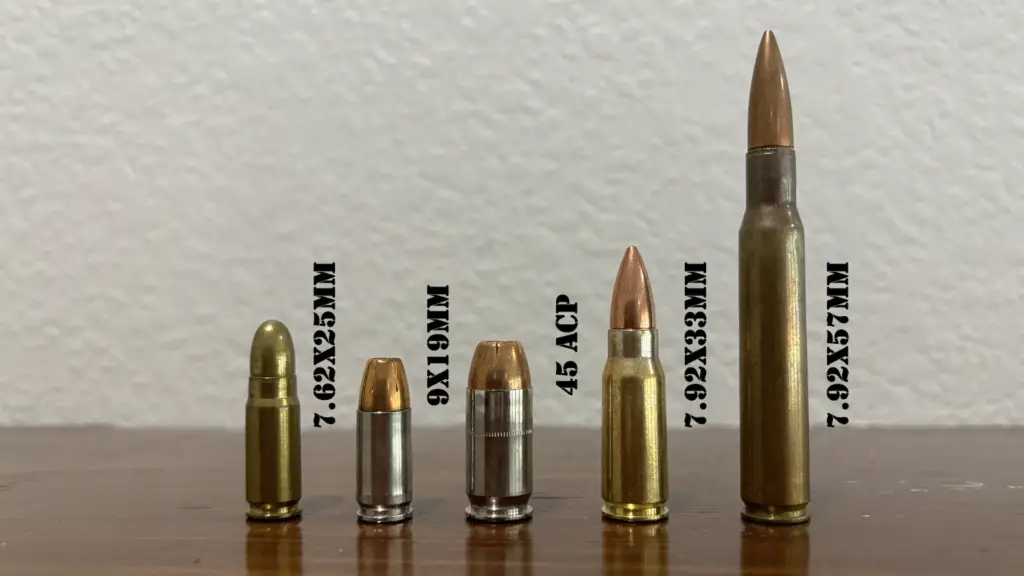
For that reason, the various armies supplemented the rifles the infantry carried with a number of different sub-machine guns chambered in pistol cartridges (like the 7.62x25mm Tokarev, 9mm Luger, and .45 ACP).
Those sub-machine guns were ideal for use at close range and had less recoil, but they didn’t have nearly as much stopping power or as long of an effective range as full-powered rifle cartridges.
Since typical combat ranges were typically between 100 and 300 yards, manufacturers set about developing intermediate-power cartridges that were more powerful and had a longer effective range than a pistol cartridge, but had lighter recoil than full-powered rifle cartridges.
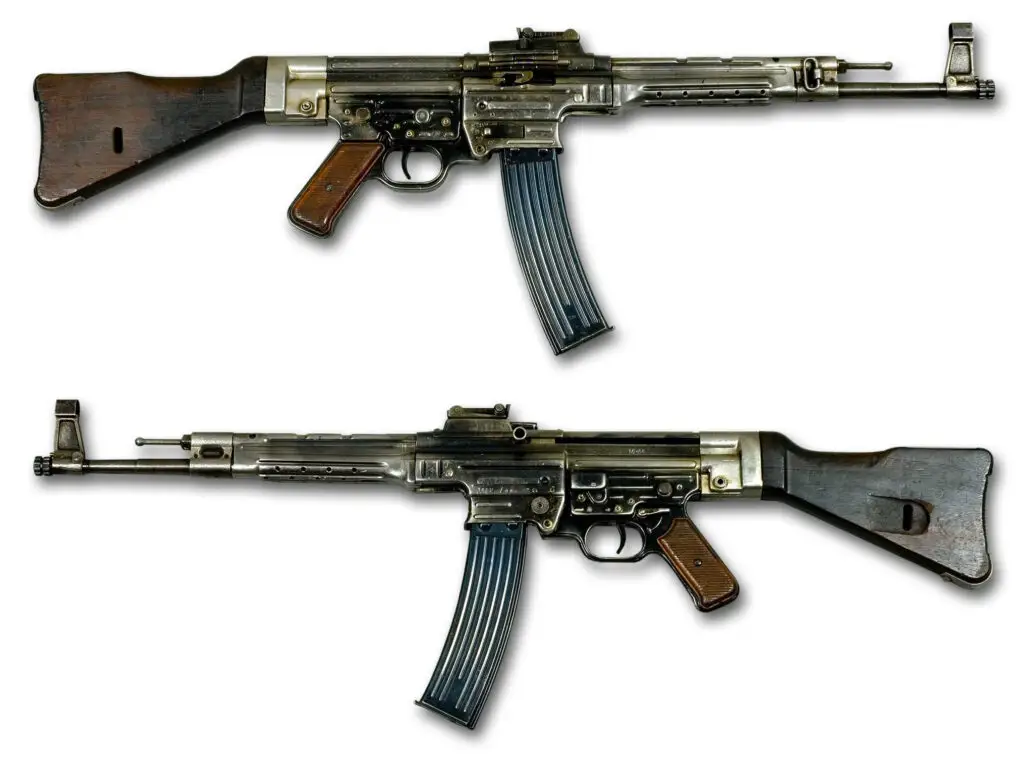
To that end, the Germans developed the StG-44 rifle and the intermediate 7.92x33mm Kurtz cartridge during World War II. The StG-44 rifle utilized a detachable box magazine and was capable of both semi and fully automatic fire.
This rifle also utilized the brand new 7.92x33mm Kurtz cartridge, which was the poster child of an “intermediate power” round with more power and a longer effective range than the pistol cartridges used in sub-machineguns (like the 9mm Luger and 45 ACP), but without the excess power and recoil of a full powered rifle cartridge like the 30-06 or 8mm Mauser.
Though it struggled at extended range and had more recoil than a sub-machinegun, the StG-44 and 7.92×33 fit the bill nearly perfectly for use at typical combat ranges.
Indeed, the Soviets decided to develop a similar rifle and cartridge.
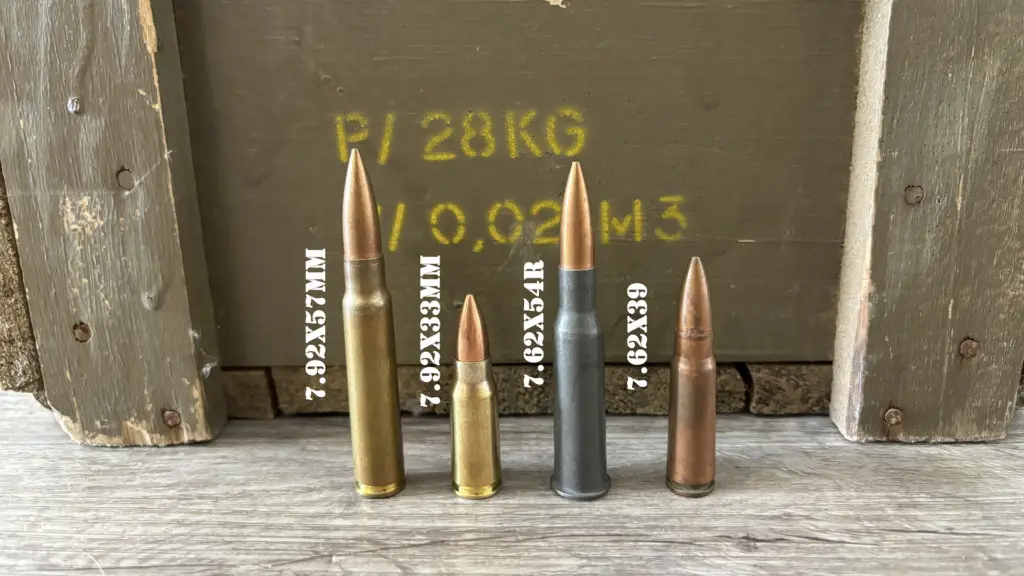
The 7.62x39mm (M43) cartridge followed in the ensuring years. The original 7.62x39mm load used by the Soviet Army shot a .311″ 123 grain boat tail full metal jacket (FMJ) bullet at a muzzle velocity of 2,300 feet per second (1,445 foot pounds of energy). With a rimless and highly tapered case to assist with reliable feeding and extraction, the 7.62x39mm rapidly caught on with the Soviet Army.
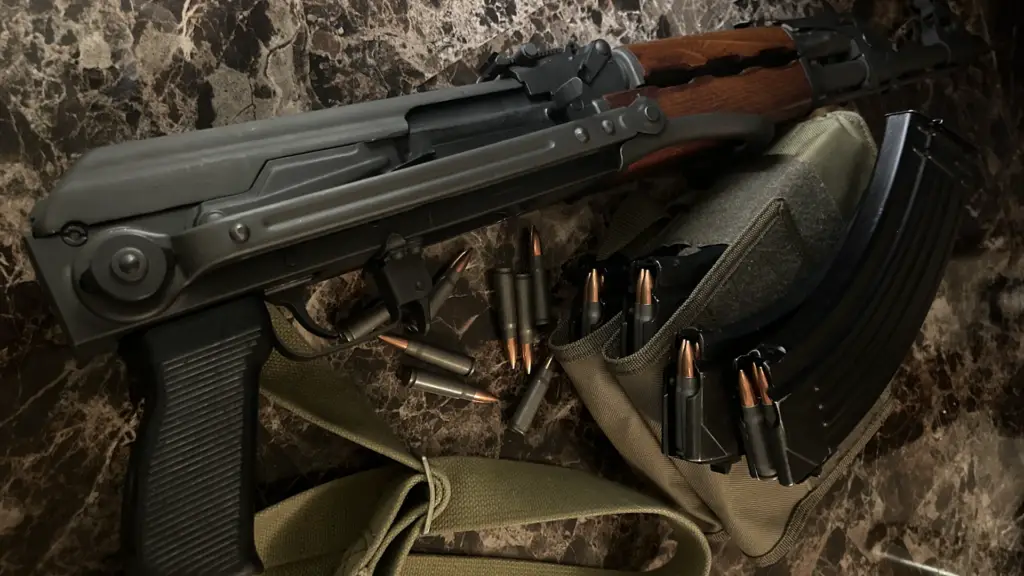
They soon adopted the semi-auto SKS rifle, the RPD machine gun, and the ubiquitous AK-47 assault rifle, which were all chambered in 7.62×39.
To read a more detailed discussion on the 7.62x39mm cartridge and how it compares to the little 223 Remington as well as the 308 Winchester and the even older 7.62x54R the Russians and Soviets used for generations, read these articles:
223/5.56 vs 7.62×39: Review & Comparison
7.62×39 vs 308 vs 7.62x54R: Everything You Need To Know
While the Soviets were traveling down that road, the US Military was going through a similar process in searching for a replacement for the .30-06 Springfield. They eventually settled on the M-14 rifle and the 7.62x51mm NATO cartridge as initial replacements for the .30-06 and M-1 Garand.
However, many leaders weren’t pleased with the M-14 because it was heavy and difficult to control when firing in full automatic mode. Essentially, it didn’t really solve a lot of the issues they had identified with the .30-06 and the M-1 Garand a few years earlier. For those reasons, the the US Air Force, Army, and Marine Corps eventually switched over to the M-16 rifle and the 5.56x45mm cartridge in the 1960s.
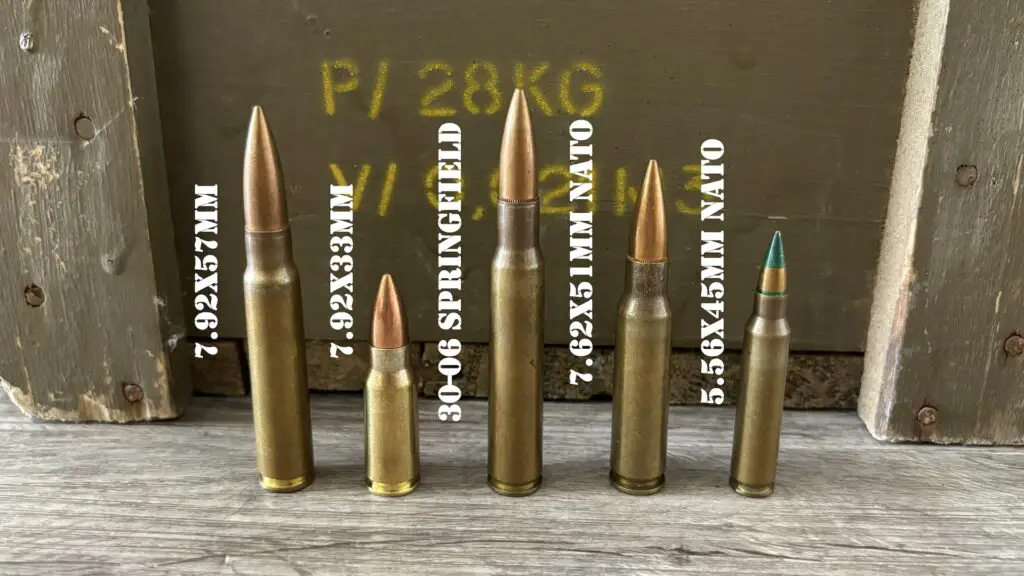
To read a more detailed discussion on the reasons the United States made that switch, as well as the differences between the .223 Remington and .308 Winchester cartridges, read this article:
.223 vs 308: Which Is Better For You?
While the M-16 and the 5.56x45mm cartridge had some major teething problems during the Vietnam War, modifications to the rifle and the cartridge itself solved many of those issues and they both remain in service with military forces all over the world today. Even so, many Soldiers and Marines who used the M-16 in combat complained about the poor stopping power of the 5.56x45mm cartridge, particularly the M855 ball load.
These issues led to the development of a series of larger caliber cartridges designed to function in modified AR-15 rifles like the 6.5 Grendel, 6.8 Remington SPC, .458 SOCOM, and the .50 Beowulf.
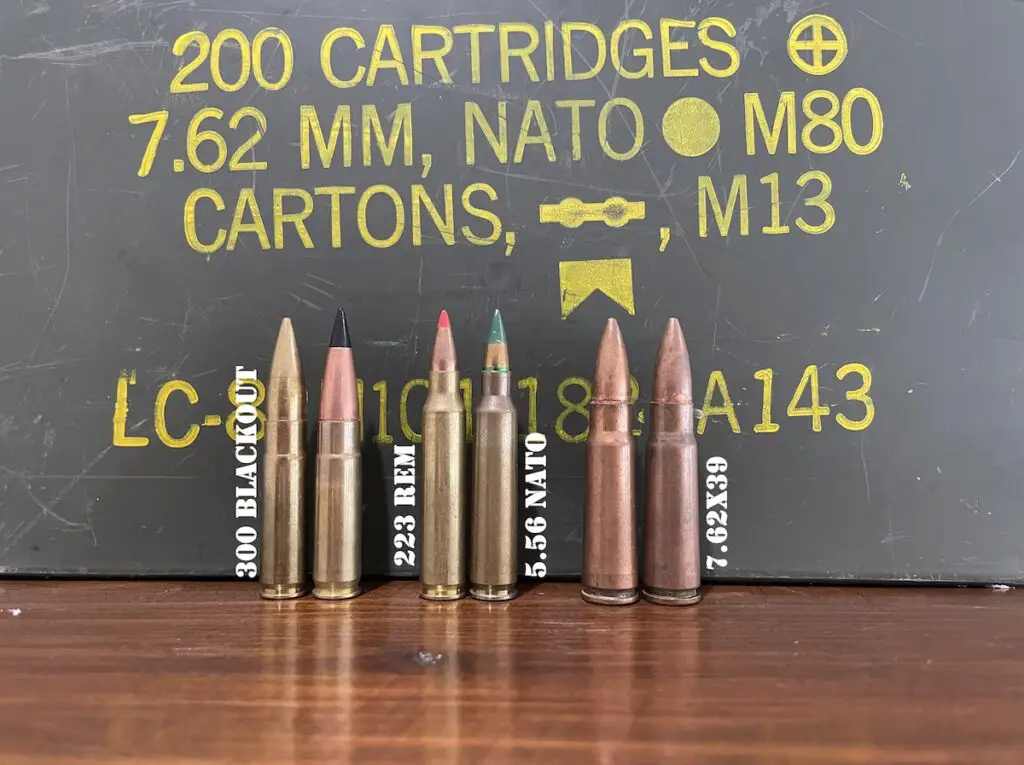
Around the same time, leaders in the military started to look for a new cartridge that could reliably shoot .30 caliber bullets from an M-16 or M-4 rifle while still using a standard bolt and gas system. Additionally, they wanted a cartridge dimensionally similar enough to the 5.56x45mm that a standard M16/AR magazine could still hold 30 rounds of the new cartridge without any modifications.
They found the solution with the .300 Whisper cartridge. Designed by JD Jones of SSK Industries in the 1990s, the .300 Whisper used a .221 Remington Fireball case necked up to shoot .30 caliber projectiles. However, since the .300 Whisper was a wildcat cartridge, designers at Advanced Armament Corporation (AAC) made a few modifications to the cartridge and got it approved by SAAMI as the .300 AAC Blackout. This allowed the cartridge to enter large scale production with the major ammunition manufacturers.
Also known as the .300 BLK or the 7.62x35mm, the .300 Blackout is available in several different supersonic loads. For instance, Barnes manufactures a load shooting a 110gr TAC-TX at a muzzle velocity of 2,350 feet per second (1,349 foot pounds of energy). Hornady produces a load shooting a 125gr hollow point at 2,175 feet per second (1,313 foot pounds of energy).
At the same time, the .300 Blackout also functions reliably in a suppressed M-16/M-4 (as well as with the AR platform) when using subsonic ammunition like Sellier & Bellot’s load shooting a 220 gr FMJ at 1,060 feet per second (549 foot pounds of energy) from a 16″ barrel.
6.5 Grendel vs 300 Blackout: Ultimate Guide
.300 Blackout vs 7.62×39: Cartridge Sizes
You can see the differences between the 7.62x39mm and .300 Blackout cartridges in the photos below.
One big difference between the two cartridges to keep in mind is that even though they are both classified as .30 caliber cartridges, the 7.62×39 and .300 Blackout do not use the same diameter bullets.
Like most American .30 caliber cartridges (the .30-30 Winchester, .30-06 Springfield, .300 Win Mag, etc.), the .300 Blackout uses .308″ bullets. However, depending on where the specific firearm and ammo in question where manufactured, the 7.62×39 typically uses .310″ or .311″ bullets. This is because the Russians measure bore diameter differently from Americans (more details on that here).
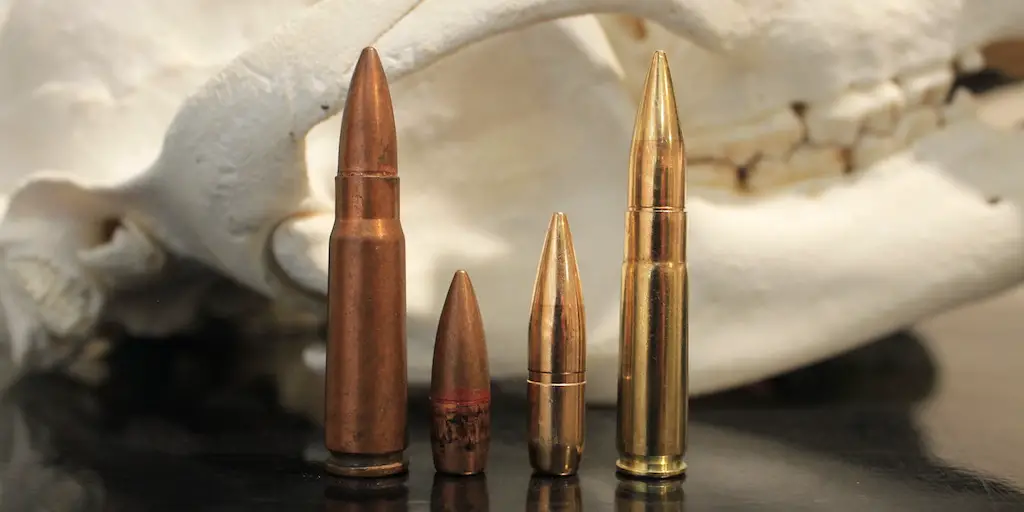
Though they are similar in overall size, the .300 Blackout has a slightly longer overall length (2.26″ vs 2.2″), but the 7.62x39mm has a slightly longer case length (1.528″ vs 1.368″).
The picture above compares a Norinco 7.62x39mm cartridge with a 122gr FMJ bullet to a Sellier & Bellot .300 Blackout cartridge with a 220gr subsonic FMJ bullet. So, while there is a stark contrast in bullet size between the two cartridges in the photo, that’s not the case when the .300 Blackout is using a lighter 125gr bullet.
Additionally, since the .300 Blackout is designed for use with a standard M-16/M-4 bolt, it has the same size rim diameter (.378″) as the .223 Remington/5.56 NATO. The 7.62x39mm cartridge has a larger (.447″) rim diameter, but also has a highly tapered case to facilitate reliable feeding and extraction.
Even though the 7.62x39mm cartridge has a more highly tapered case (which is why AK-47 magazines have such an exaggerated curve), the larger rim diameter and longer case of the 7.62x39mm cartridge result in about 45% more case capacity than the .300 Blackout.
Note: while the case capacity figures listed below do give a good indication of the differences between the two cartridges, exact case capacities vary slightly according to the brand of brass used.

7.62×39 vs 300 Blackout Ballistics
As you’d expect from their similar overall size, the ballistics of the .300 Blackout and 7.62×39 are pretty similar as well when using similar weight bullets. In fact, they’re both roughly comparable to the .30-30 Winchester.
However, the .300 Blackout is available in a wide range of bullet weights. So not all .300 BLK loads are created equal.
For instance, the vast majority of 7.62x39mm factory loads shoot bullets in the 120-125 grain range. Of these, 122 grain and 123 grain loads are by far the most common. On the other hand, most .300 Blackout factory loads use bullets in the 78-226 grain range. 110 grain, 120 grain, 125 grain, 150 grain, 208 grain, and 220 grain bullets are the most popular.
As you can see in the table below comparing the 110gr Barnes TAC-TX (.289 BC) and 190gr Horandy Sub-X subsonic (.437 BC) loads in .300 Blackout to a 123gr Hornady SST (.295 BC) load in 7.62x39mm, the ballistics of the two cartridges are pretty similar.
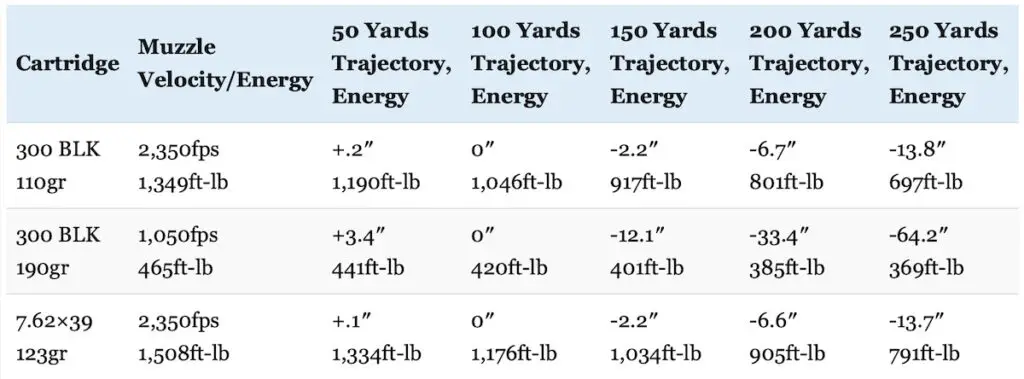
The 7.62×39 starts off with more kinetic energy than the supersonic 300 Blackout load because it’s firing a heavier bullet at the same velocity as the 300 Blackout load.
For all intents and purposes, there is very little difference in the trajectory of the .300 Blackout and 7.62×39. The 7.62×39 does have substantially more retained energy though, especially at shorter range (~12% more at the muzzle and at 100 yards).
Both rounds tend to work best at close range: ideally 200 yards and closer for both (especially the 300 Blackout).
That’s obviously not the case with the subsonic .300 Blackout ammo, which has a very low muzzle velocity and therefore a quite short effective range.
In fact, I’d wager that almost every single complaint I’ve heard about the performance of the 300 Blackout was from someone using subsonic ammo.
As you can see, that load has lots of bullet drop. Most subsonic loads produce unimpressive wound tracks as well. I can’t think of a worse load to use hunting than a subsonic FMJ 300 Blackout. Something designed to expand at lower impact velocities like the 190gr Sub-X here is better, but still nothing compared to a supersonic 300 Blackout load with a purpose built hunting bullet like the Barnes TAC-TX.
Additionally, the recoil characteristics of the two cartridges are pretty similar as well. When fired from a Ruger Mini-14/Mini-30, the .300 Blackout has slightly less than recoil than the 7.62×39. That being said, both cartridges have a relatively mild recoil that most shooters should be able to handle without any trouble.
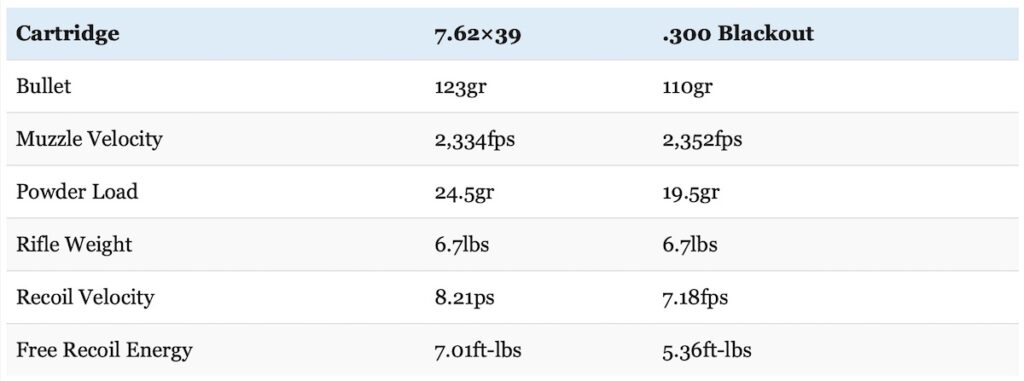
Felt recoil will vary from shooter to shooter and rifle to rifle, but free recoil energy is still a useful way to compare the two cartridges.
The 7.62×39 has gotten a bad reputation for accuracy over the years. This is probably due to the fact that most people shooting the cartridge are using cheap military surplus ammo. In fact, a good quality SKS or AK is capable of surprisingly good accuracy when using quality ammunition.
That being said, even under the best circumstances, the 7.62×39 is generally at a pretty significant disadvantage in terms of accuracy when compared to the .300 BLK, which is popular for competition shooting in some circles.
Though it’s easy to choose a winner when it comes to accuracy of the .300 Blackout vs 7.62×39 at short range, neither cartridge is really suitable for long distance shooting.
.300 Blackout vs 7.62×39: Ammunition Selection
Since the .300 Blackout and 7.62x39mm are relatively popular cartridges, there are a number of ammunition manufacturers that produce ammo for both of them like Federal, Fiocchi, Hornady, Sellier & Bellot, and Winchester.
That being said, copper washed FMJ bullets with a steel case produced by Brown Bear, Tula, or Wolf are by far the most common choices for 7.62x39mm ammo out there.
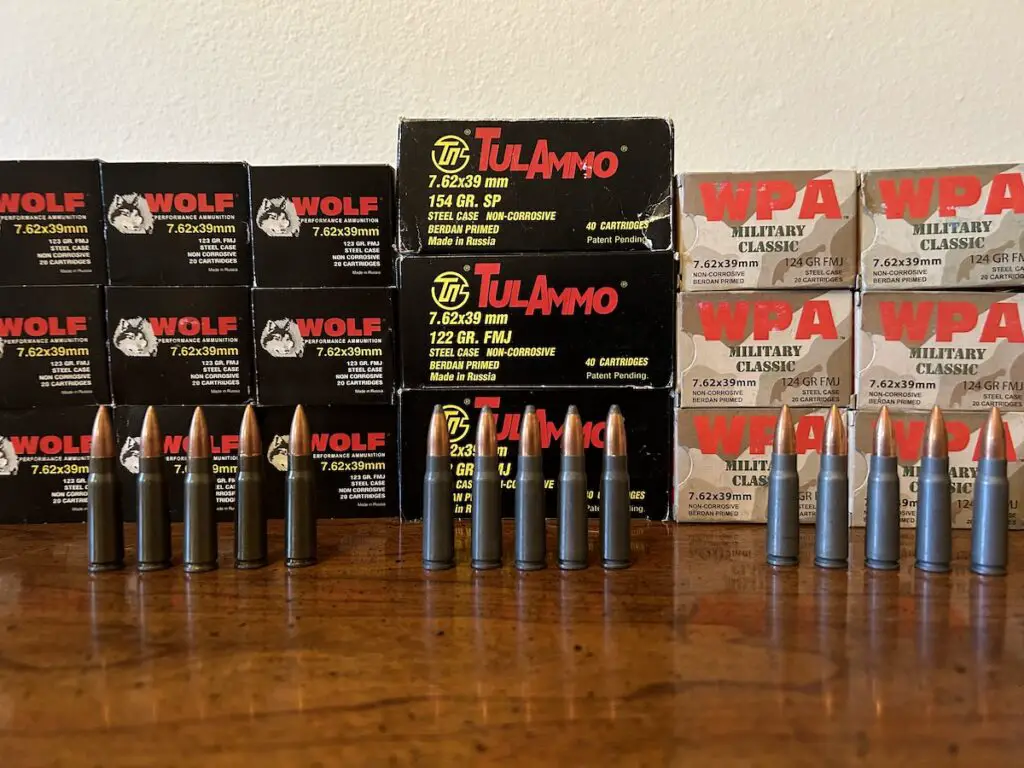
These bullets use a steel core and are not allowed at many shooting ranges. However, those same companies do make soft point or hollow point 7.62×39 hunting ammunition as well.
There are purpose built 7.62x39mm hunting ammunition options available from some American companies too. For instance, Federal offers the cartridge in their Power Shok line with a 123gr soft point and Remington offers it in their Core Lokt line with a 125gr Pointed Soft Point.
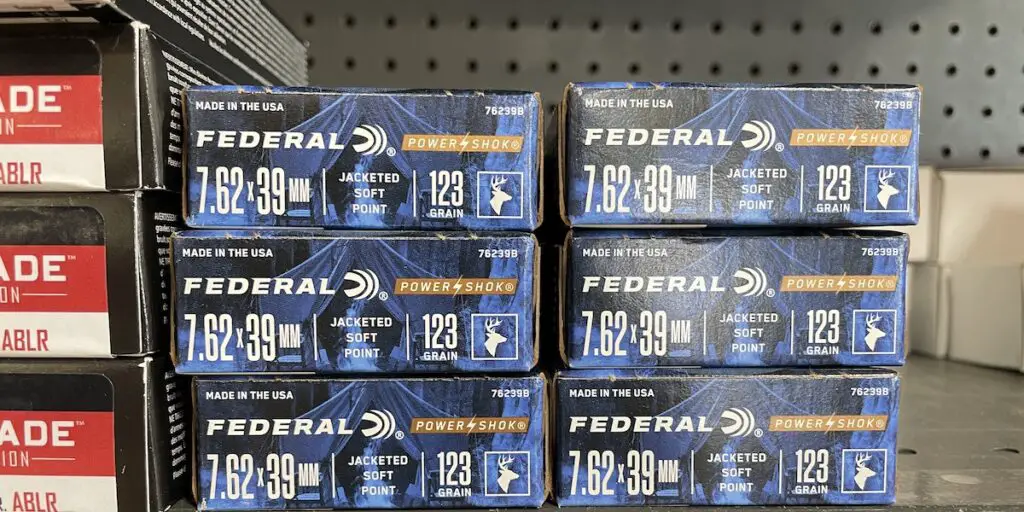
Hornady offers a couple of 7.62x39mm loads as I type this: 111gr MonoFlex and 123gr SST bullets in their BLACK line and even a 255gr Sub-X load in their Subsonic line.
On the other hand, there is a much wider variety of ammunition for the .300 Blackout. This ammo ranges from plain old FMJ and open tip match (OTM) best suited to work at the range on one end of the spectrum to hollow point and ballistic tip ammo designed for hunting and personal protection on the other end.
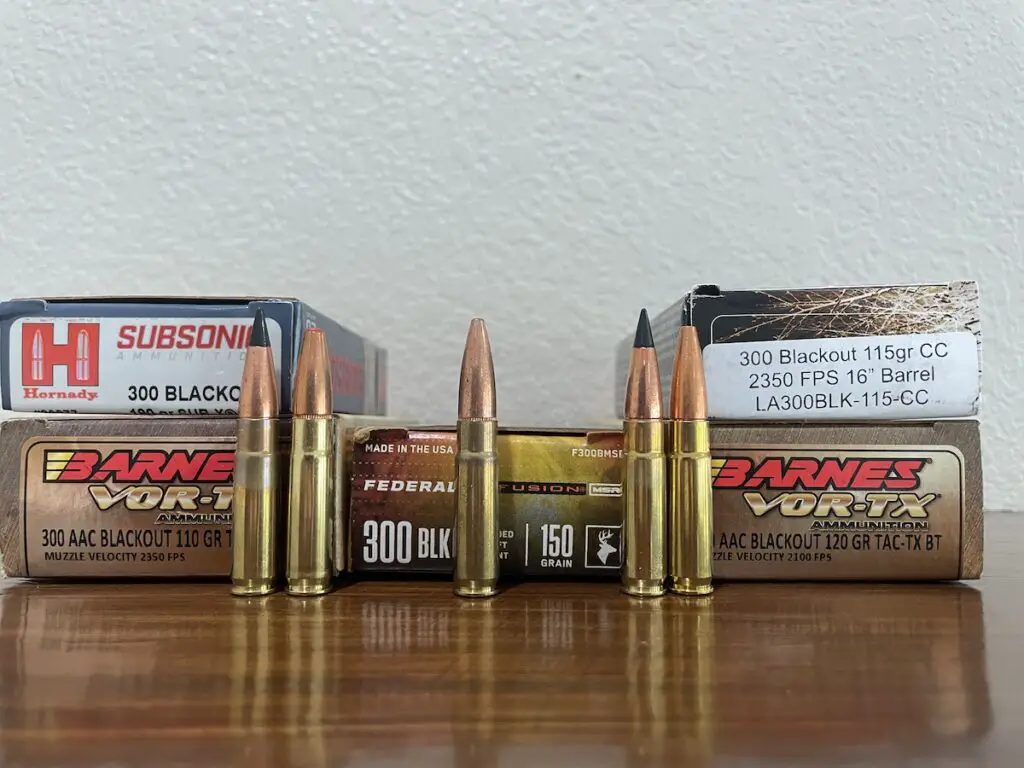
Those 110gr and 120gr TAC-TX loadings from Barnes are absolutely outstanding 300 Blackout hunting choices!
There are also a variety of subsonic ammo choices available for the 300 Blackout as well (to include one from Hornady that should work well for hunting).
Prices and availability for each cartridge vary from region to region, but 7.62×39 ammo is generally much more common and much less expensive than .300 Blackout ammunition.
BUY SOME QUALITY 300 BLACKOUT AMMO HERE
BUY SOME GREAT 7.62x39mm AMMO HERE
If you’d like to learn more about some of the various hunting ammunition choices for the 300 Blackout and 7.62×39, read these articles:
Best 300 Blackout Ammo For Hunting Deer, Hogs, Predators, And Other Game
Best 7.62×39 Ammo For Hunting Deer & Other Big Game
If you’re into hand loading, then components for the .300 Blackout are much more common, though it’s certainly possible to reload for the 7.62×39 as well. Be careful about trying to reload 7.62x39mm brass though: most of the stuff out there is Berdan primed, which will require different equipment from the Boxer primed brass most American cartridges use. Additionally, while there are tons of good quality .308 caliber bullets to choose from for the .300 Blackout, .310 and .311 bullets for the 7.62×39 aren’t nearly as common (though they’re out there).
.300 Blackout vs 7.62×39: Rifle Selection
Both cartridges are most commonly chambered in semi-automatic rifles, which probably has a lot to do with the military use of the two cartridges.
For instance, both are available in the semi-automatic Ruger Mini-14/Mini-Thirty rifles.
In particular, AR platforms are extremely popular with the 300 Blackout. On the other hand, the 7.62×39 is available in a number of AK clones.
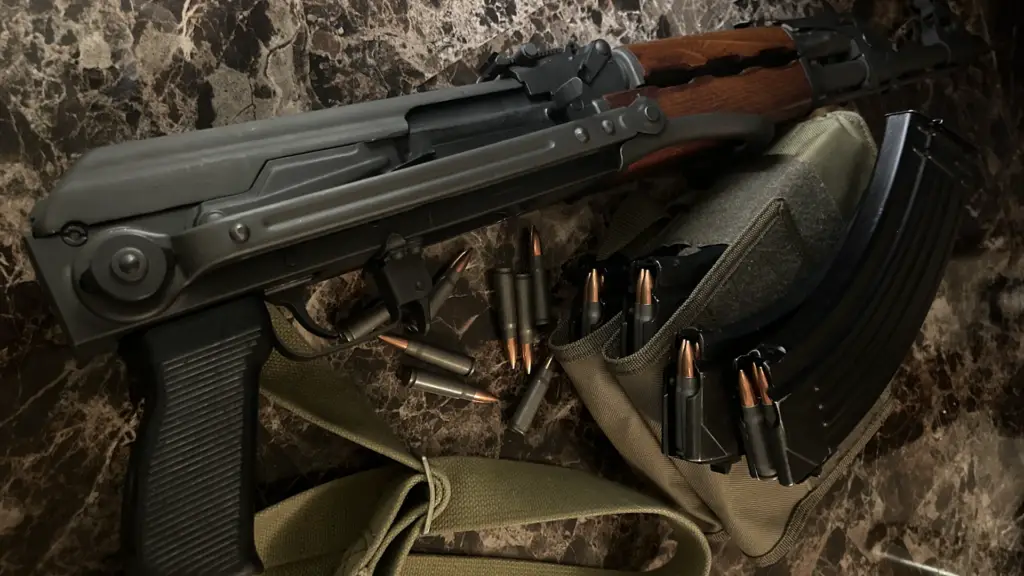
There are a few AR-15 variants chambered in 7.62×39, but they’re not nearly as common. This is because the extreme taper of the cartridge necessitates the use of special magazines and the larger rim diameter of the cartridge requires a new bolt, bolt carrier, firing pin, etc.
It will work, but it just takes some more effort than a 300 Blackout AR.
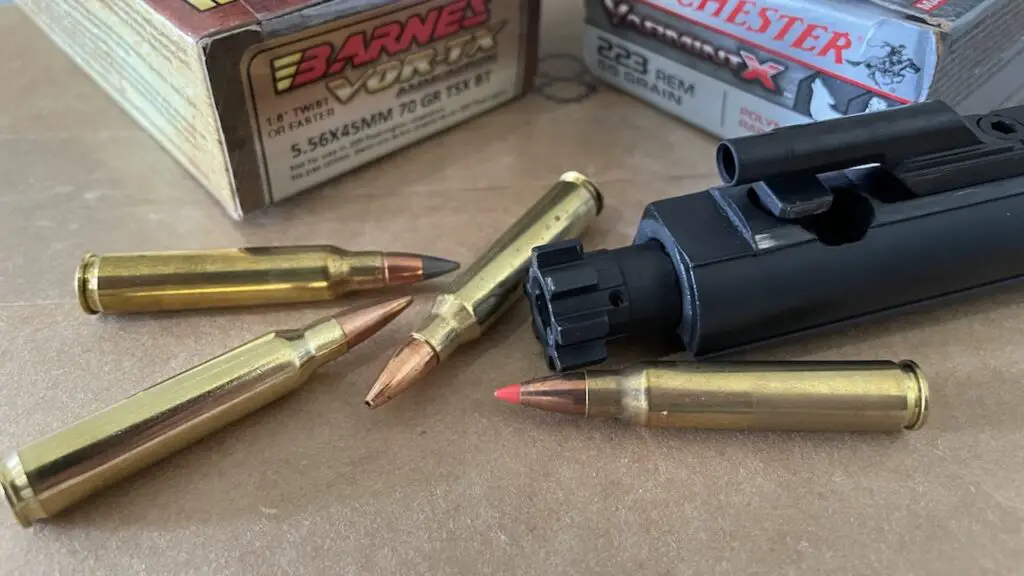
The .300 Blackout is also available in bolt action rifles like the Mossberg MVP Scout, the Savage Axis, the Savage 110, the CVA Cascade, and the Christensen Arms Ridgeline Scout.
CVA also makes a version of their single shot CVA Scout rifle in 300 Blackout too.
Both cartridges are available in a few other rifles like the Ruger American Ranch bolt-action rifle.
Howa also makes their Mini rifle in 7.62×39 as well.
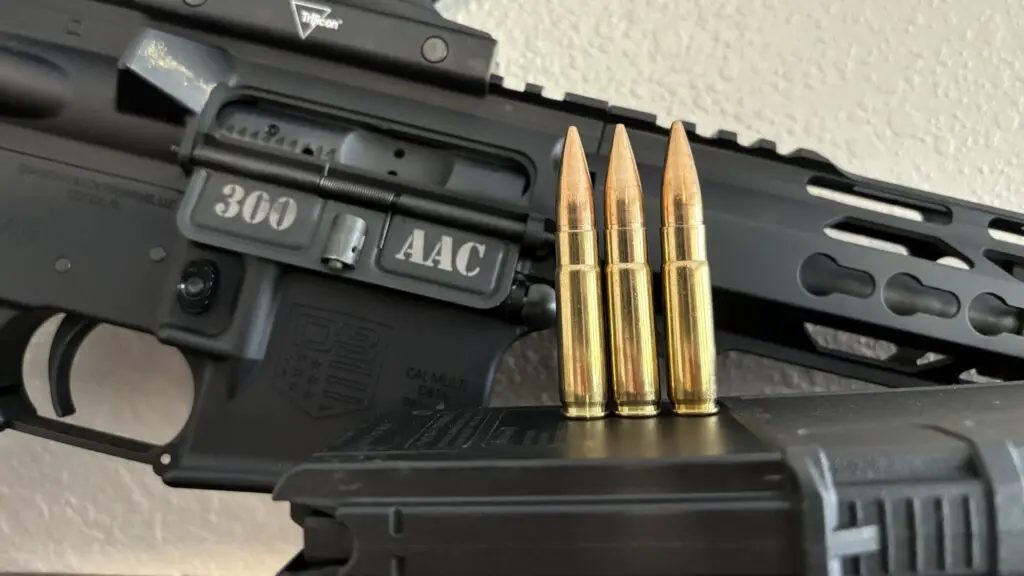
One last thing on rifles: the 300 Blackout tends to work better out of shorter barrels.
Remember: this is literally one of the specific use cases the cartridge was designed for.
Designers accomplished this feat by building the cartridge to use a relatively small charge of fast burning pistol powder that generates peak velocities out of a shorter barrel length.
As a result, the 300 Blackout doesn’t gain much velocity out of barrels longer than 16″, but the cartridge also doesn’t suffer as large of a reduction in velocity by going to an even shorter barrel.
On the flip side, the 7.62×39 has a larger powder capacity and typically uses slower burning rifle powders. This means the cartridge has a slightly higher “ceiling” on its performance, but also needs a longer barrel for complete powder burn.
For example, most companies advertise velocities for their factory ammo in most rifle cartridges with 24” barrels, but they typically use a 16” barrel for the 300 Blackout.
For reference, Hornady advertises 7.62x39mm velocities with a 20” barrel on their web site for factory ammo and in their 10th Edition Reloading Manual for handloads. Likewise, Nosler uses a 22″ barrel for their 7.62x39mm handloads in their 9th Edition Reloading Handbook.
However, both companies use 16″ barrels for their 300 Blackout handloads in both manuals. The same is true for Hornady 300 Blackout factory loads.
BUY AN EXCELLENT 300 BLACKOUT RIFLE HERE
BUY A DEPENDABLE 7.62x39mm RIFLE HERE
7.62×39 vs 300 Blackout Magazines
We can’t have a 7.62×39 vs 300 Blackout comparison without discussing the magazine situation for each cartridge. In particular, this section is focused on magazines for use in AR-15 and AK rifles.
First, since it’s more closely related to the 223 Remington cartridge and has a similar enough overall shape, the 300 Blackout can use regular AR-15/M-16 rifle/M-4 carbine magazines designed for use with the 223/5.56 cartridge without modifications.
Those magazines also still retain a 30 round capacity.
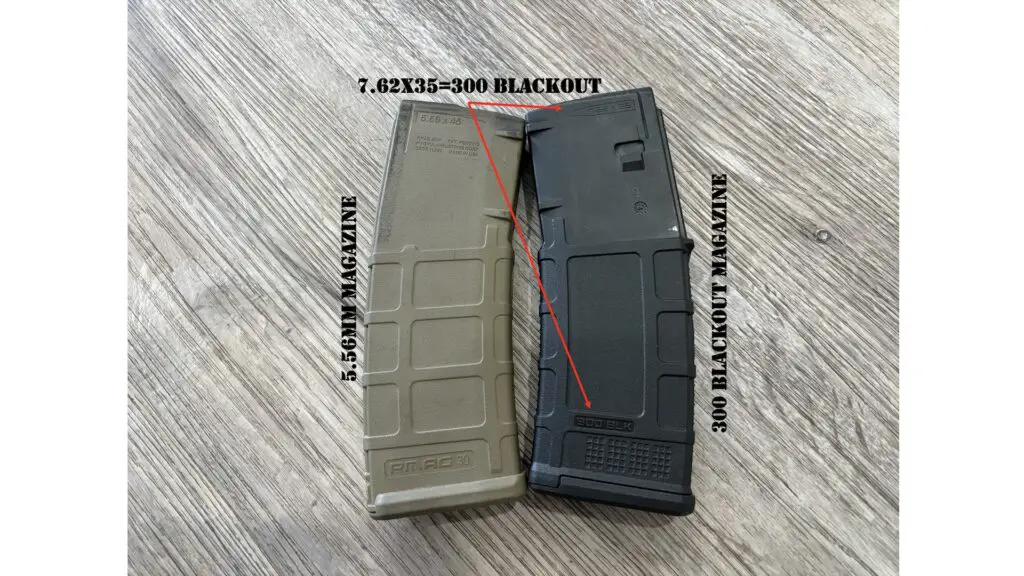
You can purchase 300 Blackout magazines if you want the absolute best reliability, but regular 223 or 5.56 NATO magazines will often work just fine with the 300 Blackout though.
So, keep that in mind if you already have a pile of Magpul mags for your AR-15.
There is one vitally important safety consideration to keep in mind for those who own rifles chambered in both 223/5.56 and 300 Blackout though: a 300 Blackout cartridge CAN indeed chamber and fire with catastrophic results in a 223 Remington or 5.56 NATO chamber.
Trying to push a 30 caliber bullet down a 22 caliber bore will likely destroy your rifle and potentially cause severe injury or death as a result.
Those who own rifles chambered in both cartridges should exercise particular care to avoid mixing ammunition for the two cartridges.
For this reason alone, I think it’s a good idea to purchase dedicated 300 Blackout magazines to further reduce the odds of a serious accident occurring due to mixing ammunition.
Magpul and Lancer (among other companies) produce high quality 300 Blackout magazines with good reputations (both are available below).
BUY SOME EXCELLENT 300 BLACKOUT MAGAZINES HERE
Things are a little different for the 7.62×39.
Since the 7.62x39mm cartridge uses a more tapered case, larger capacity 7.62x39mm magazines have a distinct “banana” type shape.
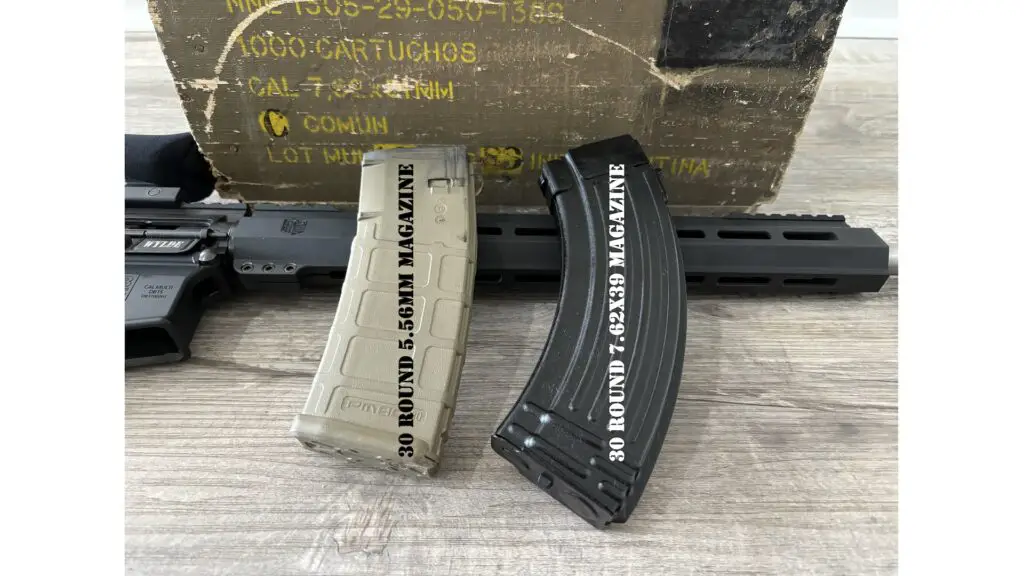
There are a TON of different 7.62x39mm AK magazines out there ranging from heavy, steel magazines to lighter polymer models. The good news is that most of those magazines aren’t very expensive and many of them work really well too.
You need to be more careful with 7.62x39mm AR magazines though.
No need to get too clever here: just get a few steel Duramag 7.62×39 AR magazines and you should be fine (available below)
BUY SOME GREAT 7.62x39mm MAGAZINES HERE
.300 Blackout vs 7.62×39: Which Is Right For You?
The 7.62×39 and .300 Blackout are both well suited for hunting medium game at short to moderate range. The .300 Blackout has a slight advantage here because of its generally better accuracy and larger selection of quality hunting bullets, but they’ll both work for hunting game like deer and feral hogs out to 100 (maybe 150) yards or so with good shot placement (be sure to use a good scope on your deer rifle) and when using quality bullets.
Basically, if you consider the .30-30 Winchester adequate for the job, then the .300 Blackout and 7.62×39 should also do just fine in the same situation. Be sure to wear ear protection if you’ll be hunting with supersonic ammo!
For instance, this gentleman took a great looking buck with a Ruger American Ranch rifle chambered in 7.62×39 shooting that Hornady 123gr SST load I mentioned earlier.

Another hunter took the buck below with a single shot with a Barnes 120gr TAC-TX from his 300 Blackout.

In that vein,
The 300 Blackout in particular gets a lot of use with hunters pursuing feral hogs, especially at night and with thermal scopes. That Hornady Subsonic load would be a great choice for use with a suppressor to quickly and quietly eliminate hogs without as big of a chance of spooking others in the group.
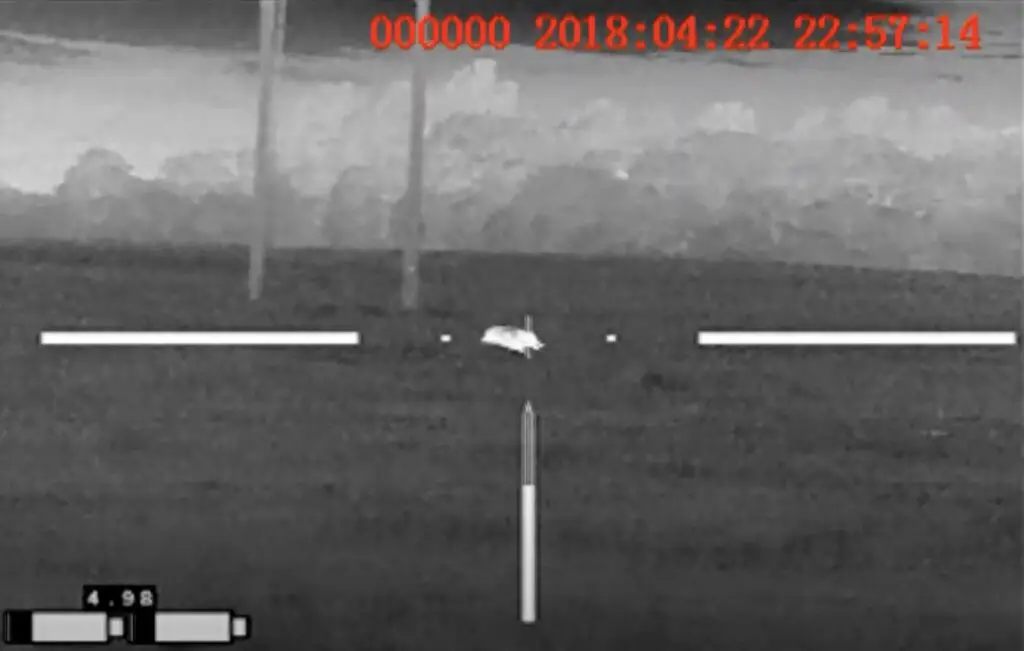
A shot to the head or neck with one of those rounds will quickly drop that hog in its tracks. You might be in for a long tracking job with a body shot though, so keep that in mind!
This is why a lot of people prefer to stick with the harder hitting supersonic 300 Blackout ammo, like those Barnes loads I keep mentioning.
Do you want the ideal cartridge to use with a suppressor or in rifles with short barrels? The .300 Blackout has a big advantage over the 7.62×39 in those areas. Because the .300 Blackout is designed for use in a standard AR style rifle, it will still cycle the bolt reliably when using subsonic ammunition and with a barrel length shorter than 16″. Additionally, it doesn’t suffer nearly as big of a drop off in performance as the 7.62×39 when using a shorter barrel either.
Are you looking for a cartridge with good prospects for widely available and inexpensive ammo? The 7.62×39 wins in this area hands down. It’s consistency among the top 10 most popular cartridges in the United States in terms of the amount of ammo sold each year. There’s also still a lot of inexpensive military surplus ammunition available. .300 Blackout ammo isn’t hard to find, but it’s a lot more expensive and not nearly as widespread as the 7.62x39mm.
Are you looking for an ideal cartridge to use in an AR-15 platform? Both will work, but the .300 Blackout has a big advantage here because it was specifically designed for optimum performance in the M-16/M-4. By the same token, if you really like AK style rifles, then the 7.62×39 is the obvious choice.
Are you very sensitive to recoil? Both have very mild recoil, but the .300 Blackout has less than the 7.62×39.
Do you want a cartridge suitable for self-defense? Both will certainly work in this regard, but there are more choices of purpose built self-defense ammo for the .300 Blackout (like the Barnes TAC-TX, Lehigh Defense Close Quarters Bullet, and others) than the 7.62×39.
As I’ve stated multiple times: the .300 Blackout and 7.62×39 are very similar in many respects and are both very capable rifle cartridges. While they each have different strengths, the differences between them (.300 Blackout vs 7.62×39) aren’t nearly as large as they’re made out to be sometimes.
For a detailed discussion about another alternative to the .223 Remington in the .224 Valkyrie, 6.5 Grendel, and 6.8 SPC, read the articles below:
224 Valkyrie: Should You Buy One?
6.8 SPC vs 6.5 Grendel: What You Need To Know
Enjoy this article about the .300 Blackout vs 7.62×39 debate? Please share it with your friends on Facebook and Twitter.
Nosler provided the load data used to compare trajectory, case capacity, and recoil for the 300 Blackout vs 7.62×39 mm cartridges (here and here). Ballistic Studies provided information on the original M43 7.62x39mm load. The Lyman 50th Edition (p231-233 & 270-271) and Hornady 10th Edition (p435-443 & 618-621) reloading manuals were also used as references for this article.
Make sure you subscribe to The Big Game Hunting Podcast and follow The Big Game Hunting Blog on Facebook, Instagram, Twitter, and YouTube.
NEXT: BEST 6.5 CREEDMOOR AMMO FOR HUNTING ELK, DEER, & OTHER BIG GAME
NEXT: 101 BEST GIFTS FOR HUNTERS
NEXT: BEST RIFLE SLINGS
John McAdams is a proficient blogger, experienced shooter, and long time hunter who has pursued big game in 8 different countries on 3 separate continents. John graduated from the United States Military Academy at West Point and is a veteran of combat tours with the US Army in Iraq & Afghanistan. In addition to founding and writing for The Big Game Hunting Blog, John has written for outdoor publications like Bear Hunting Magazine, The Texas State Rifle Association newsletter, Texas Wildlife Magazine, & Wide Open Spaces. Learn more about John here, read some of John’s most popular articles, and be sure to subscribe to his show: the Big Game Hunting Podcast.

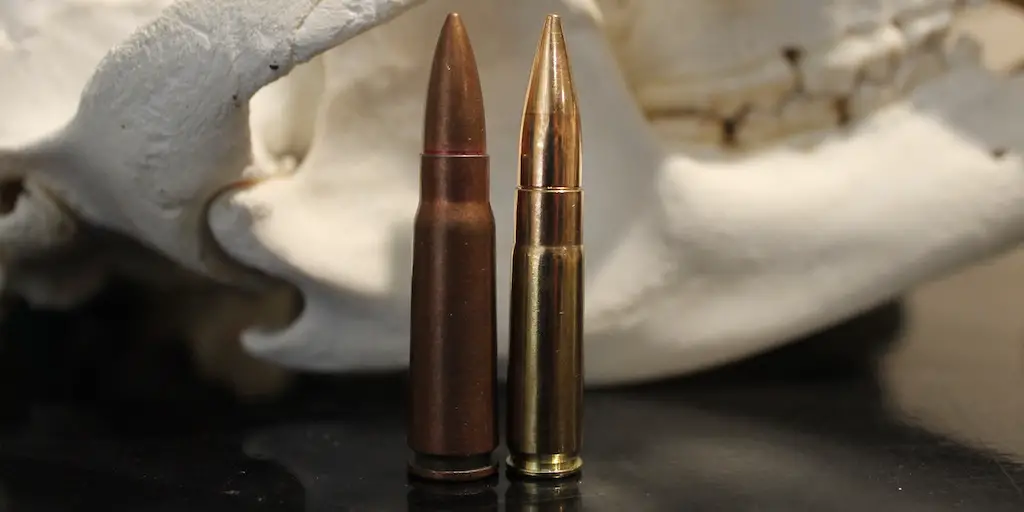

Technically Russian ammo has a bi-metal jacket with a lead core, not a steel core. Two reasons they are not allowed on ranges. One, the bi-metal jacket can damage backstops and two, they can spark and possibly ignite unburned powder or fine dust/vapors.
For ranges most people will fire a gun at, the 30/30>7.62X39>300 blackout, ballistic-wise. I think that’s pretty clear from the data above. Small differences perhaps, but still, a fair statement. In the end, the 7.62×39 caliber has a downside, and that is that for the most part, it’s not manufactured here. That means it’s subject to the whims of politicians, wars, restrictions on import, etc. Plenty of tac guys in the military and police business take bad guys out quickly and efficiently with that little 5.56 bullet, there are all sorts of bullet options now. The key is always shot placement. If you can put 3-4 shots into the kill zone per second, the bad guy doesn’t have much of a chance regardless of bullet, unless he is armored-up. The 5.56 is not a round for deer hunting, it’s not an appropriate caliber. 30/30 / .243 are probably the floor for humane deer hunting.
Hornady and Winchester both make 7.62x39mm.
Sure the 300 Blackout is better. But I have 2 ARs in 7.62×39. One takes AK mags and the other AR style mags. In an AR platform the 7.62 might surprise you. The 20 inch Upper reall likes Tula hollw point for some reason. I have shot 1 inch 3 shot groups at 100 yards Also Federal soft point. We have property in west Texas. Out to about 125 yards they are hog killing machines. Plus cheap ammo for plinking. Never shot 300 blackout so I can’t compare.
There’s no question that I can load the 7.62×39 to absolutely stomp a 300 Blackout. The chart above is misleading. They are apparently dealing only with junk Eastern Block ammo (.311 projectiles) that barely makes 4 MOA at 100 yards in most Eastern Bloc platforms. In an AR I can take Starline brass and load up a 110gr Nosler Varmageddon Ballistic tip bullet (.308s) with 27.0gr of Vihtavouri N120 and shoot about 1 MOA at 230 yards with a MV of 2480fps. That’s a Shaw 20″ barrel (Model 1 in TX). The case capacity of each cartridge dictates it’s capability. Also, burn rate and quantity of powders. Most 300 blackouts are loaded with H110 or a similar fast burning magnum pistol powder. The 7.62×39 is the parent of 6.5 Grendel, and those cases can take slower powders in greater quantity up to about the burn rate of Reloader 10x and H335. I also can load up 174gr 308 bullets to do subsonic work if you want to do that sort of thing, again, with better powders.